
The Preservation Resource Center is a non-profit organization which promotes the historic preservation of buildings and architecture in New Orleans.

The Preservation Resource Center is a non-profit organization which promotes the historic preservation of buildings and architecture in New Orleans.
New Orleans is a city famous for its architecture. From the townhouse apartments of the French Quarter to the shotgun houses of Uptown, New Orleans features a wide array of architectural styles, styles which are often unique to the city. It is a visible testament to the rich history and culture of the city.
However, New Orleans has suffered from the same problems with sinking property values and urban decline as other major cities. Many historic structures have been threatened with demolition. Even the now famous French Quarter was once a neglected immigrant ghetto in the early 20th century, which was also threatened with destruction. In the 1960s, there had been a serious attempt by the federal government to demolish the French Quarter's scenic riverfront and replace it with an interstate highway. [1]
The Preservation Resource Center promotes the protection of historic architecture in New Orleans, which it believes are vital to the economy, culture, and aesthetics of the city. The organization also advocates the involvement of citizens and communities in the restoration of historic neighborhoods and buildings. Most of the organization's programs are directed toward several target historic neighborhoods in the city. [2]
The Preservation Resource Center was founded in 1974. It is governed by a president and a board of directors. As of 2006, the Preservation has 21 full-time and part-time employees and annual budget of $1.4 million. Its numerous outreach and renovation projects rely on federal grants, donations, and a community of volunteers and members.
The offices of the Preservation Resource Center are located in the historic Leeds-Davis Building in the Warehouse District, near the National World War II Museum and Ernest N. Morial Convention Center. The building was built by the noted New Orleans architect James Gallier in 1853, during the antebellum period of New Orleans history. The structure features a restored cast-iron Gothic Revival facade. Preservation purchased the Leeds-Davis Building in March 1998, and financed an extensive modernization and renovation of the structure for the next two years. It moved into its new office on November 11, 2000. The building features a classroom and a showroom on the first floor. The office is located at 923 Tchoupitoulas Street, New Orleans, Louisiana 70130. Phone: (504) 581.7032. E-Mail: prc@prcno.org. [3]
The Preservation Resource Center is politically active in supporting legislation which favors historic preservation and works to prevent legislation which favors unrestricted development. In the past, the organization has lobbied for legislation which saved the federal tax credit for historic rehabilitation, created a property tax abatement for home renovation, and established zoning measures which favored historic neighborhoods and properties. The organization frequently joins neighborhood associations in city planning sessions with the New Orleans City Council and other government agencies. It has been involved in legal cases which have prevented the demolition of specific houses and neighborhoods. [4]
The Preservation Resource Center sponsors several events and information workshops for homeowners each year. Many of these seminars are held in the organization's office building, and they are open and free of charge to the general public. The organization also publishes material relating to the renovation of historic homes and buildings. The organization has a monthly magazine, Preservation in Print, which publicizes events relating to historic preservation, and features articles on historic neighborhoods and buildings. [5]
Operation Comeback promotes the purchasing and renovation of vacant historic properties, instead of the demolition of existing structures and the construction of new buildings. Established in 1987, the original objective of the program was the revitalization of the Coliseum neighborhood in the Lower Garden District. [6] Today, Operation Comeback helps prospective homeowners locate and purchase renovated historic houses throughout the city. The program also holds interviews with homeowners and helps them finance and organize renovation projects. [7]
Originally established as "Christmas in October" in 1988, Rebuilding Together is a neighborhood revitalization program which renovates the homes of elderly, low-income, disabled homeowners. Homeowners who own a historic house can apply to have their homes renovated, and the renovations are done at no cost to the homeowners. The program relies on volunteer labor and donated supplies to perform the renovations. Both skilled and unskilled labor are invited to join the program. The program differs from the New Orleans Habitat for Humanity in that the organization renovates existing homes instead of building new ones. [8]
During Hurricane Katrina and Hurricane Rita, several historic New Orleans neighborhoods were flooded, and numerous historic buildings were severely damaged. Preservation Resource Center is currently assisting homeowners throughout the city repair their flood and wind-damaged homes. [9]

The National Trust for Historic Preservation is a privately funded, nonprofit organization based in Washington, D.C. that works in the field of historic preservation in the United States. The member-supported organization was founded in 1949 by congressional charter to support the preservation of America’s diverse historic buildings, neighborhoods, and heritage through its programs, resources, and advocacy.

Historic preservation (US), built heritage preservation or built heritage conservation (UK), is an endeavor that seeks to preserve, conserve and protect buildings, objects, landscapes or other artifacts of historical significance. It is a philosophical concept that became popular in the twentieth century, which maintains that cities as products of centuries’ development should be obligated to protect their patrimonial legacy. The term refers specifically to the preservation of the built environment, and not to preservation of, for example, primeval forests or wilderness.

Over-the-Rhine is a neighborhood in Cincinnati, Ohio, United States. Historically, Over-the-Rhine has been a working-class neighborhood. It is among the largest, most intact urban historic districts in the United States.

Renovation is the process of improving broken, damaged, or outdated structures. Renovations are typically done on either commercial or residential buildings. Additionally, renovation can refer to making something new, or bringing something back to life and can apply in social contexts. For example, a community can be renovated if it is strengthened and revived. It can also be restoring something to a former better state.
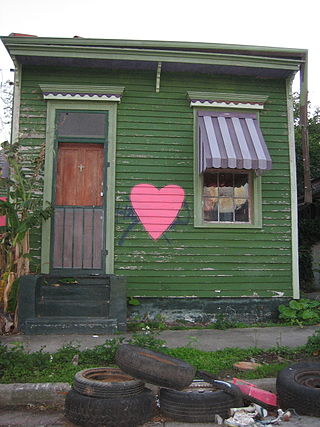
A shotgun house is a narrow rectangular domestic residence, usually no more than about 12 feet (3.5 m) wide, with rooms arranged one behind the other and doors at each end of the house. It was the most popular style of house in the Southern United States from the end of the American Civil War (1861–65) through the 1920s. Alternative names include shotgun shack, shotgun hut, shotgun cottage, and in the case of a multihome dwelling, shotgun apartment; the design is similar to that of railroad apartments.
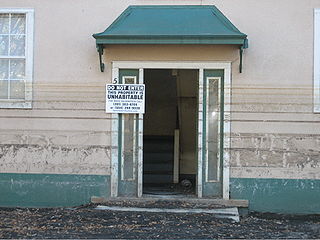
The reconstruction of New Orleans refers to the rebuilding process endured by the city of New Orleans after Hurricane Katrina destroyed much of the city on August 29, 2005. The storm caused levees to fail, releasing tens of billions of gallons of water. The levee failure contributed to extensive flooding in the New Orleans area and surrounding parishes. About 80% of all structures in Orleans Parish sustained water damage. Over 204,000 homes were damaged or destroyed, and more than 800,000 citizens displaced—the greatest displacement in the United States since the Dust Bowl of the 1930s. Wind damage was less severe than predicted. The damage that took place that needed to be repaired cost about $125 billion.

Mignon Faget is a jewelry designer based in her native New Orleans, Louisiana. Faget has long been acknowledged as one of New Orleans' premier designers of fine jewelry.
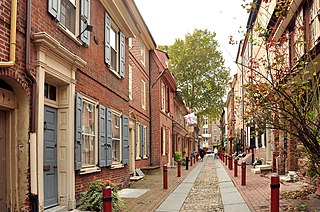
Historic districts in the United States are designated historic districts recognizing a group of buildings, properties, or sites by one of several entities on different levels as historically or architecturally significant. Buildings, structures, objects and sites within a historic district are normally divided into two categories, contributing and non-contributing. Districts vary greatly in size: some have hundreds of structures, while others have just a few.

The Tulane School of Architecture is the school of architecture at Tulane University in New Orleans, Louisiana. The school has a student body of approximately 442 students.

SBP is a nonprofit, disaster relief organization. After temporarily volunteering in St. Bernard Parish, Louisiana after Hurricane Katrina, Liz McCartney and Zack Rosenburg returned permanently in March 2006 and founded the project. The organization eventually expanded to include offices in Baton Rouge, Louisiana, Joplin, Missouri, Columbia, South Carolina, New Jersey, New York, and West Virginia. By August 2022, SBP's national impact included assistance to 5,500 families, including the rebuilding of over 1,200 homes, including 600 in New Orleans. They have collaborated extensively with Toyota and Americorps. As a result of its accomplishments, the organization and its founders have been recognized by Senator Mary Landrieu, CNN, and President Barack Obama.

In the law regulating historic districts in the United States, a contributing property or contributing resource is any building, object, or structure which adds to the historical integrity or architectural qualities that make the historic district significant. Government agencies, at the state, national, and local level in the United States, have differing definitions of what constitutes a contributing property but there are common characteristics. Local laws often regulate the changes that can be made to contributing structures within designated historic districts. The first local ordinances dealing with the alteration of buildings within historic districts was passed in Charleston, South Carolina in 1931.

The buildings and architecture of New Orleans are reflective of its history and multicultural heritage, from Creole cottages to historic mansions on St. Charles Avenue, from the balconies of the French Quarter to an Egyptian Revival U.S. Customs building and a rare example of a Moorish revival church.

Herron–Morton Place is a historic district in Indianapolis, Indiana, United States. The boundaries of the neighborhood are East 16th Street on the south, East 22nd Street on the north, North Pennsylvania Street on the west, and Central Avenue on the east.
Vieux Carré Property Owners, Residents, and Associates, organized in the 1920s, is a pioneer organization in the historic preservation movement that grew out of several grass roots efforts to protect the 200-year-old Vieux Carré from decay and demolition. In 1936 the Louisiana state legislature passed a constitutional amendment authorizing the historic preservation of the Vieux Carré. Two years later on June 8, 1938 the neighborhood organization incorporated as a non-profit dedicated to the preservation, restoration, beautification and general betterment of the Vieux Carré.
Baltimore Heritage is an American nonprofit historic-preservation organization headquartered in Baltimore, Maryland.

This is a list of the Davenport Register of Historic Properties in Davenport, Iowa, United States.

Riverside and Avondale are two adjacent and closely associated neighborhoods, alternatively considered one continuous neighborhood, of Jacksonville, Florida. The area is primarily residential, but includes some commercial districts, including Five Points, the King Street District, and the Shoppes of Avondale.
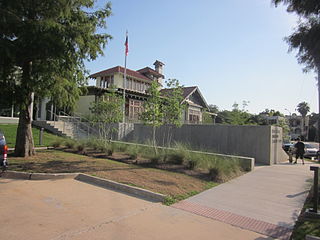
The Rosa F. Keller Library and Community Center is located in the Broadmoor neighborhood of New Orleans, Louisiana. It stands on the corner of Napoleon Avenue and South Broad Street which serve as the north/south, east/west markers in the neighborhood. The library is a branch of the greater New Orleans Public Library System. The Broadmoor branch serves as one of the only centers for community engagement in the neighborhood and hosts adult education classes, art workshops, after-school activities for children, and community events throughout the year. It opened its doors on March 17, 2012.
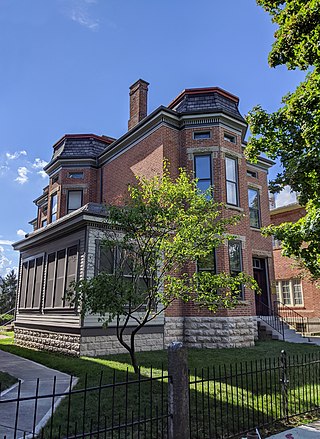
The Columbus Landmarks Foundation, known as Columbus Landmarks, is a nonprofit historic preservation organization in Columbus, Ohio. The foundation is best-known for its list of endangered sites in the city and its annual design award, given to buildings, landscapes, and other sites created or renovated in Columbus.